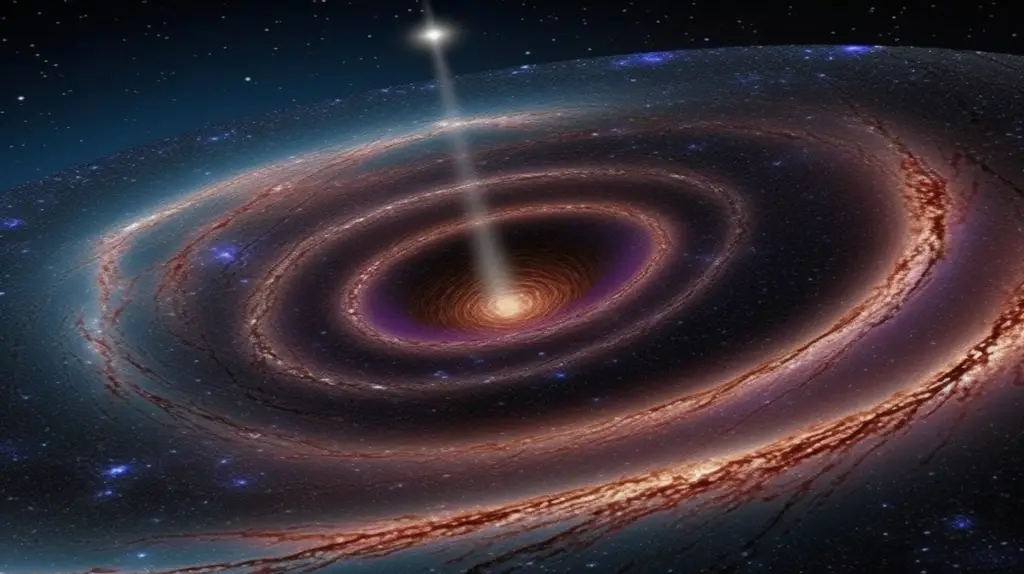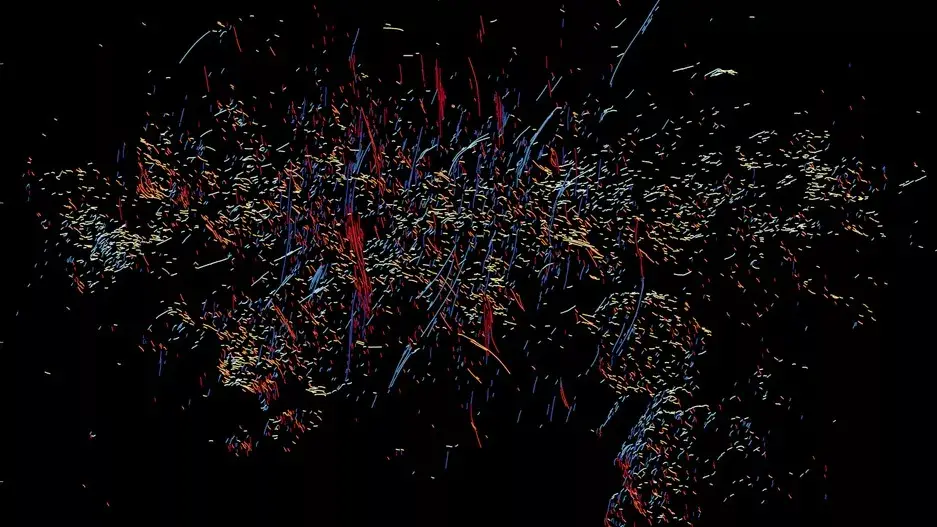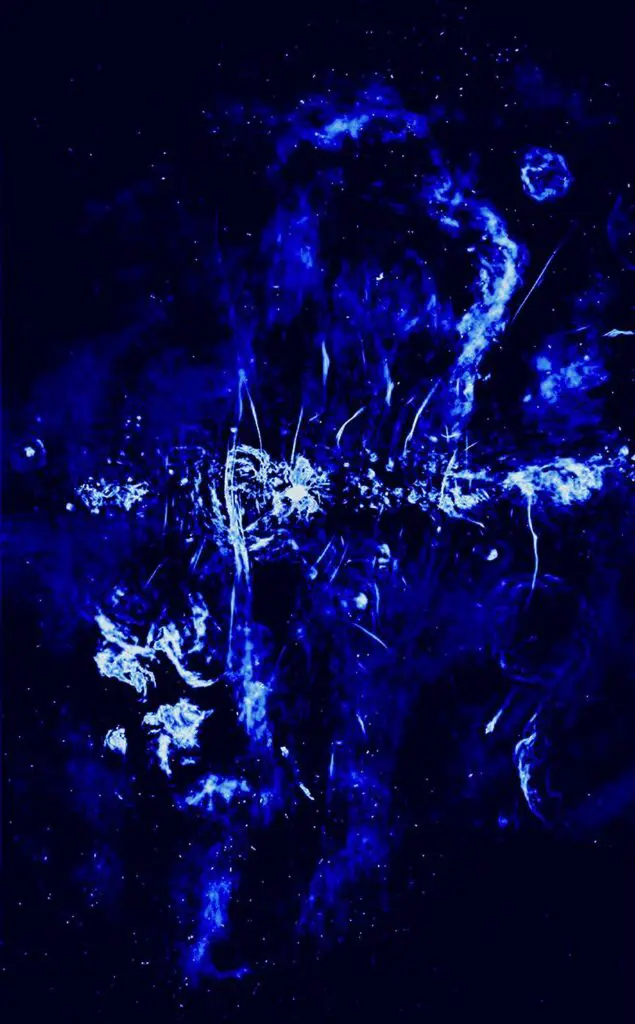Astronomers have unveiled hundreds of ancient, invisible structures at our galaxy’s center, offering new insights into the enigmatic activities of our supermassive black hole.

Table of Contents
Unearthing the Galactic Marvels: Invisible Structures At Our Galaxy’s Center
Radio astronomers have recently announced an extraordinary discovery: hundreds of long, thin structures believed to have originated from our galaxy’s supermassive black hole. These unusual formations, invisible to the naked eye, have transformed our understanding of the Milky Way and the cosmic activity at its heart.

The Mystery of the Filaments: Tracing the Path of an Ancient Black Hole
This discovery of unusual stringlike structures has pointed astronomers towards an exciting hypothesis. Researchers posit that these might be the remnants of a violent black hole eruption from eons ago. Published on June 2 in The Astrophysical Journal Letters, the study reveals that each filament measures between 5 and 10 light-years in length, visible only in radio wavelengths.
This remarkable ‘award-winning image of Comet Leonard’ is not CGI or artist’s illustration
Connecting the Invisible: The Galaxy’s Central Supermassive Black Hole
Interestingly, these hundreds of filaments collectively seem to be oriented towards the galaxy’s central supermassive black hole, possibly suggesting they are residual scars of an ancient, high-energy black hole outburst that ripped through the surrounding gas clouds.
The Surprise Discovery: Filaments Pointing to the Black Hole
The lead study author, Farhad Yusef-Zadeh, a professor of physics and astronomy at Northwestern University, expressed his astonishment at finding a new population invisible structures at our galaxy’s center seemingly directed towards the black hole. These filaments are not arbitrarily distributed but appear to be associated with the outflow of the black hole.

Unraveling Sagittarius A: The Monstrous Center of Our Galaxy*
The Milky Way’s central supermassive black hole, Sagittarius A* (Sgr A*), possesses mass exceeding 4 million suns, anchoring our galaxy through its intense gravitational pull. However, it has also been the source of some severe interstellar disruptions.
Previous Observations: Ancient Eruptions and Mysterious Phenomena
Previous radio observations led by Yusef-Zadeh revealed colossal energy bubbles extending 25,000 light-years above and below Sgr A*. Additionally, approximately 1,000 vertical, string-like radio filaments seemed to spring from Sgr A*. Both phenomena, Yusef-Zadeh proposed, were likely produced by an ancient outburst from our galaxy’s black hole.
Decoding the New Filaments: Enhanced Radio Observations
To detect the new filaments, the researchers enhanced recent observations from the South African Radio Astronomy Observatory’s MeerKAT telescope and minimized background noise from nearby energy sources. The images highlighted the new filaments’ thinness, similar to the vertical filaments previously discovered, but these invisible structures at our galaxy’s center seem to radiate only from one side of Sgr A*.
Evaluating Differences: The New and the Old
While these newly discovered invisible structures at our galaxy’s center mirror their vertical counterparts in certain aspects, key differences emerge. They are shorter, fewer in number, and unlike the vertical ones, they radiate from only one side of Sgr A*. Despite these variations, the researchers suspect the new structures were created by a similar energy outburst from our galaxy’s central black hole, likely around 6 million years ago.
The Next Steps: Challenging Ideas and Strengthening Analysis
While this discovery opens up new avenues for exploring the violent past life of our galaxy’s center, further radio observations are needed to refine the understanding. Yusef-Zadeh concluded that they must continue challenging their ideas and refining their analysis to truly grasp the complex history of the cosmic behemoth at our galaxy’s heart. The ongoing study of these intriguing invisible structures at our galaxy’s center promises to enhance our understanding of the galaxy and the universe’s broader mysteries.
The Phenomenon of Black Hole Outbursts: A Cosmic Enigma
Black holes, the ultimate cosmic enigma, have baffled scientists for years. The sudden outbursts from these entities are powerful enough to disrupt the interstellar medium and create complex structures like the filaments observed in this study. These outbursts likely result from an accumulation of matter around the black hole, which, due to the immense gravitational force, spirals inward, releasing a tremendous amount of energy in the process. This energy outflow can, in turn, carve large-scale structures in the surrounding medium, leaving behind fascinating formations, such as the filamentary structures uncovered by Yusef-Zadeh’s team.
The Role of Radio Astronomy: Unlocking Secrets of the Invisible Universe
One of the unique aspects of this discovery is the application of radio astronomy. The universe is alive with action across the entire electromagnetic spectrum, but only a small fraction of it is visible to the naked eye. Most cosmic activity, including the high-energy particle bursts that likely created these filaments, occur at wavelengths outside the optical range, which only radio telescopes can detect. Hence, these observatories serve as essential tools in studying the invisible universe and providing new insights into the nature and history of our galaxy.
Future Implications: Unlocking the Galactic Past
What do these findings imply for our understanding of the Milky Way? These newly discovered filaments offer a unique window into the past activity of our galaxy’s central supermassive black hole. If these invisible structures at our galaxy’s center indeed resulted from an ancient black hole eruption, they could provide clues about the frequency and impact of such outbursts. In other words, we may be looking at a “fossil record” of our galaxy’s violent history. This information could be crucial in forming a more comprehensive picture of our home galaxy’s evolution.
The Potential for Further Research: A New Era of Galactic Exploration
The discovery of these filaments marks only the beginning of a new era in galactic exploration. Future research can further investigate these invisible structures at our galaxy’s center, mapping their extent, understanding their composition, and determining their exact origin. These studies could include more extensive radio observations and the incorporation of data from other wavelengths. The scientific community may also explore other galaxies for similar phenomena, which could offer further insights into the nature and behavior of supermassive black holes.
Unraveling the Mysteries: The Path Forward
Despite the significant strides we’ve made in space exploration, our understanding of the universe remains limited. Unraveling the mysteries of supermassive black holes and their influence on their surrounding environments is a crucial step in our cosmic journey. The discovery of these filaments represents a leap forward in this quest, shedding light on the otherwise dark and mysterious nature of our galaxy’s core. As we delve deeper into these invisible structures at our galaxy’s center, we get closer to decoding the mysteries of the universe, one filament at a time.
Reference(s):

